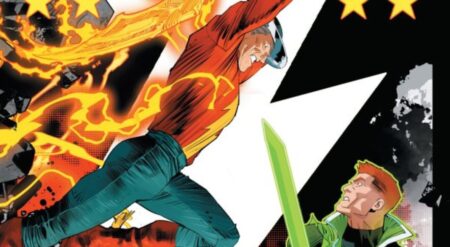
Dial H For Hero #1 is published by DC Comics under the Wonder Comics Imprint and is written by Sam Humphries, with art by Joseph A. Quinones Jr., and letters by Dave Sharpe. The comic follows Miguel who has had a fascination with being a superhero since childhood after being saved by Superman following a serious fall. However, Miguel’s daredevil ways lead him to trouble after a jump gone wrong leads him to become the newest wielder of the Hero Dial, a rotary phone-like device that grants the user superpowers for one hour when they dial H-E-R-O.
So far, I have been pretty divided on the Wonder Imprint’s line of comics. Young Justice and Wonder Twins have been subpar to okay at best, while Naomi has been downright phenomenal. The concept of Dial H For Hero is kooky and bizarre enough to work, considering it is part of the Wonder Imprint. However, there is a serious tonal disconnect between the first and second half of this issue.
At the start, Miguel is a regular kid with a daredevil, adrenaline-fueled attitude wanting nothing more than to be super-powered like the hero who saved him all those years ago, Superman. Miguel doesn’t have a Billy Batson Shazam! moment and there is no major consequence or lesson in this issue when Miguel gets his newfound powers.
From the script and even the art style change, it suddenly feels like a different, lesser comic in the second half, after he becomes super-powered. I will be honest, there are some writers that I should know by now that I simply do not enjoy and Humphries seems to be one of them. I have tried to read his work multiple times and so far, nothing has clicked.
That being said, Quinones Jr.’s work is excellent. His art including the clearly different style he creates when Miguel gets his powers after dialing the phone is unique. The colors are very vibrant but the shading differences between the pages are important to note. When Miguel has powers, the comic specifically looks like an older comic, with shading and coloring closer to something that would have been published in the 1990s.
Even the lettering choices between the two are wildly different creating this dichotomy and while visually it is very interesting, there is so little transition in the script it is confusing. I actually initially thought I was reading an ad or what some comics occasionally do where an older book will be reprinted as a special edition. The script did not do enough to join these elements together, or transition into the new look.
Overall, the art in this book is pretty, but it is not enough to make me want to pick up issue two in the future. Fans of the original concept might be interested but I don’t know if new readers will be quite as interested in this book as DC Comics hopes.
Dial H For Hero #1 is available now wherever comic books are sold.
Dial H For Hero #1
TL;DR
Overall, the art in this book is pretty, but it is not enough to make me want to pick up issue two in the future. Fans of the original concept might be interested but I don’t know if new readers will be quite as interested in this book as DC Comics hopes.






